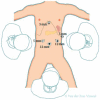Laparoscopic distal pancreatectomy for benign and malignant disease: a review of techniques and results
- PMID: 35664025
- PMCID: PMC9165340
- DOI: 10.5114/pg.2021.109625
Laparoscopic distal pancreatectomy for benign and malignant disease: a review of techniques and results
Abstract
Diagnosis of pancreatic cancer is challenging in the initial phases because its progression is rapid. The pancreatic tail and body roughly accounts for 20-30% of all cancerous cases. The standard treatment for symptomatic benign, malignant, and premalignant diseases of the pancreatic tail and body is distal pancreatectomy. This technique has been modified over the years to fit certain indications, with the goal of enhancing post-operative results as well as reducing patient trauma. In cases of a premalignant and symptomatic benign condition, the spleen must be preserved either using Kimura's splenic vessel preservation technique or Warshaw's splenic vessel resection technique. A better long-term prognosis is ensured by regional lymph node dissection and radical R0 resection. Radical antegrade modular pancreatosplenectomy was proposed to tackle the shortcomings of traditional surgery for pancreatic tail and body cancer. In this review, study techniques and results of laparoscopic distal pancreatectomy for malignant and benign pancreatic ailments were described with the intention of providing knowledge on various suitable techniques reported for pancreatic cancer treatment. Furthermore, this study will serve as a ready reckoner for surgeons and could serve to boost their confidence levels during surgery by avoiding confusion on the selection of suitable for the pancreatic diseases diagnosed.
Keywords: Kimura technique; Warshaw technique; laparoscopic distal pancreatectomy; open distal pancreatectomy; pancreatic cancer; radical antegrade modular pancreatosplenectomy.
Copyright © 2022 Termedia.
Conflict of interest statement
The authors declare no conflict of interest.
Figures
Similar articles
-
Geographical variation and trends in outcomes of laparoscopic spleen-preserving distal pancreatectomy with or without splenic vessel preservation: A meta-analysis.Int J Surg. 2017 Sep;45:47-55. doi: 10.1016/j.ijsu.2017.07.078. Epub 2017 Jul 21. Int J Surg. 2017. PMID: 28735894 Review.
-
Technical Aspects of Laparoscopic Distal Pancreatectomy for Benign and Malignant Disease: Review of the Literature.Gastroenterol Res Pract. 2015;2015:472906. doi: 10.1155/2015/472906. Epub 2015 Jul 9. Gastroenterol Res Pract. 2015. PMID: 26240565 Free PMC article. Review.
-
Laparoscopic spleen-preserving distal pancreatectomy with or without splenic vessel conservation: a retrospective study of 20 cases.Hepatogastroenterology. 2013 Oct;60(127):1785-8. Hepatogastroenterology. 2013. PMID: 24624457
-
Laparoscopic radical antegrade modular pancreatosplenectomy for left-sided pancreatic cancer using the ligament of Treitz approach.Surg Endosc. 2017 Nov;31(11):4836-4837. doi: 10.1007/s00464-017-5561-6. Epub 2017 Apr 13. Surg Endosc. 2017. PMID: 28409377
-
Distal pancreatectomy with partial preservation of the spleen: a new surgical technique.Gland Surg. 2023 Nov 24;12(11):1624-1635. doi: 10.21037/gs-23-355. Epub 2023 Nov 17. Gland Surg. 2023. PMID: 38107487 Free PMC article.
Cited by
-
Enucleation of insulinoma using laparoscopic distal pancreatectomy with a focus on vascular and splenic preservation: a case report.J Surg Case Rep. 2024 Aug 30;2024(8):rjae561. doi: 10.1093/jscr/rjae561. eCollection 2024 Aug. J Surg Case Rep. 2024. PMID: 39220171 Free PMC article.
-
Laparoscopic total pancreatectomy with total mesopancreas dissection using counterclockwise technique and tail-first approach.Ann Hepatobiliary Pancreat Surg. 2025 Feb 28;29(1):79-82. doi: 10.14701/ahbps.24-176. Epub 2024 Nov 12. Ann Hepatobiliary Pancreat Surg. 2025. PMID: 39528245 Free PMC article.
References
-
- Venkat R, Edil BH, Schulick RD, et al. . Laparoscopic distal pancreatectomy is associated with significantly less overall morbidity compared to the open technique: a systematic review and meta-analysis. Ann Surg 2012; 255: 1048-59. - PubMed
-
- Nakamura M, Nakashima H. Laparoscopic distal pancreatectomy and pancreatoduodenectomy: is it worthwhile? A meta-analysis of laparoscopic pancreatectomy. J Hepatobiliary Pancreat Sci 2013; 20: 421-8. - PubMed
-
- Kimura W, Inoue T, Futakawa N, et al. . Spleen-preserving distal pancreatectomy with conservation of the splenic artery and vein. Surgery 1996; 120: 885-90. - PubMed
-
- Warshaw AL. Conservation of the spleen with distal pancreatectomy. Arch Surg 1988; 123: 550-3. - PubMed
-
- Davies JM, Lewis MP, Wimperis J, et al. . Review of guidelines for the prevention and treatment of infection in patients with an absent or dysfunctional spleen: prepared on behalf of the British Committee for Standards in Haematology by a working party of the Haemato-Oncology task force. Br J Haematol 2011; 155: 308-17. - PubMed
Publication types
LinkOut - more resources
Full Text Sources

